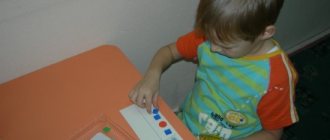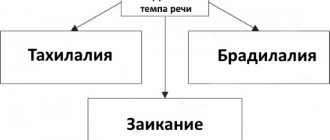Phonemic speech disorder refers to a child's inability to identify the correct sounds by ear.
This problem manifests itself in the fact that sounds are pronounced incorrectly, are deafened or voiced, are replaced from hard to soft, are skipped or rearranged in words. At the same time, the child does not notice the mistakes made, since he simply “does not hear” the difference. Phonetic-phonemic underdevelopment of speech occurs due to phonemic hearing impairment. That is, the child not only pronounces sounds incorrectly, but also cannot determine by ear which sound is needed in a particular case.
FFND can manifest itself to varying degrees:
- Defective sound pronunciation occurs due to difficulties with the analysis of phonemes.
- The child pronounces all sounds correctly, but has difficulties with phonemic hearing.
- The child's speech has problems determining the correct sound order in words.
How does phonetic-phonemic underdevelopment of speech manifest itself?
The most characteristic signs of the presence of FFND, which parents should pay attention to, may be:
- Replacing “complex” sounds in speech with easier ones to pronounce. For example, the sound P can become the sound L, hissing and whistling sounds can be replaced by explosive sounds (Ш or Ж on T or D, both hard and soft).
- Mixing sounds. That is, a child can separately pronounce phonemes that are difficult for him, but in words and sentences they are still replaced by simpler ones.
- One sound can even replace a couple or more. For example, one explosive sound can replace several hissing and whistling sounds at once.
- With correct pronunciation, a child may not be able to distinguish sounds belonging to different types by ear. In this case, the problem of phonemic violation comes to the fore.
Diagnostic measures
If symptoms of FFN are detected, parents should contact a speech therapist. There are speech therapists in every school and kindergarten. Speech therapy classes can also be attended in specialized centers.
The most popular treatment centers for FFND and general speech underdevelopment (GSD) are:
- Clinic of speech pathology in St. Petersburg.
- Center for Speech Pathology and Neurorehabilitation of Shklovsky V.M. (Moscow).
- St. Petersburg Research Institute of Ear, Throat, Nose and Speech.
- Anna Belik Speech Correction Center (St. Petersburg).
Diagnosis of FFN includes the collection of anamnestic data to determine the possible cause, as well as speech therapy examination. The doctor looks at the patient’s card or extracts from it. The specialist asks the mother about the course of pregnancy, childbirth, the mental situation in the house, the presence of functional pathologies of the brain, as well as biological and physiological changes in the body. For a doctor, the presence of mental trauma and chronic stress, which often lead to impaired speech function, is of great importance. On the eve of the first visit to speech therapy classes, the child should be examined by a neurologist or otolaryngologist to exclude mental disorders, organic brain lesions, consequences of head injuries, and diseases of the speech apparatus.
To register, the speech therapist creates a speech card for the child. In it, he describes the state of auditory function, the presence or absence of brain diseases. The card also includes general health status, vaccinations performed, and previous diseases.
The specialist examines the articulation apparatus, assesses the condition of the vocal cords and respiratory function necessary for normal speech. He does several pronunciation tests to determine which sounds the patient cannot produce. This data must be entered into the card.
The speech therapist evaluates vocabulary, the presence of substitutions and displacements of sounds, and changes in the structure of the word. The ability to construct sentences is also assessed. The doctor must pay attention to breathing while reproducing words and sentences.
If the child can write, then the speech therapist looks at the state of written speech. The doctor notes the presence of grammatical errors when writing words and replacing letters. After a complete examination, the doctor writes a conclusion and also draws up a lesson plan for correcting speech function.
Why you need to see a specialist
This problem may seem insignificant to parents. After all, even in classic children's stories, we read how cute children lisp or grumble, while possessing excellent intellectual abilities.
However, experts warn that such a violation can turn into a problem when studying at school. FFNR means, first of all, the fact that the child is not able to analyze and determine the desired sound. This entails problems with spelling, as well as dyslexia and dysgraphia. In addition, incorrect pronunciation can last a lifetime, because the child “does not see or hear” his mistake.
Articulation exercises
It is not obvious to an adult how much effort a child needs to put in to pronounce words correctly. This is done not by the power of thought, but with the help of the articulatory apparatus, which in turn consists of several important organs. The concept of correcting phonetic-phonemic underdevelopment would not exist without a general set of exercises that can improve the reproducibility of sounds in most young patients.
For active lip work
Our lips literally shape the sounds we make. The typical and familiar facial movements for us have not yet been imprinted in the child’s memory. He, trying to pronounce sounds, fails precisely because of incorrect positioning of his lips
Effective exercises:
- “Kiss” - the child is taught to stretch out his lips with a tube as if for a kiss. Actually helps with the pronunciation of vowels and sibilants.
- “Smile” - the teeth are closed, and the lips spread into the widest possible smile. Trains facial muscles of the lips. You can alternate with the previous exercise.
- “Piglet” - from the “kissing” position, the child is asked to move his closed lips in a circle, changing the direction of rotation.
For tongue training
The tongue is mostly controlled unconsciously - it rises to the palate in a calm state, and its movements during speech are difficult to distinguish for the average person. It is obvious to a specialist that the tongue is the most important part of the articulatory apparatus and it needs to be trained first.
Useful exercises:
- “Needle” - you need to stick your tongue out as far as possible, but at the same time keep it tense so that there is a sharp tip. It is advisable to hold for up to 10 seconds.
- “Scapula” - the task is also to stick your tongue out as far as possible, but in a relaxed state.
- “Medoc” causes a little difficulty for children, but is very effective. It is necessary to lick the upper lip, but not from bottom to top, but from top to bottom.
- “Tube” - roll your tongue into a tube, straining it. The rounder it is, the better.
Clicking and clicking your tongue also helps - it’s not difficult and children are happy to repeat this exercise at home.
Who should I contact?
If parents suspect that their child has speech problems, they should visit a speech therapist as soon as possible. The specialist will conduct a detailed examination and conclude whether there is a need for corrective measures.
How the examination is carried out:
- By asking the child questions or offering to perform this or that exercise, the speech therapist will determine “difficult” phonemes to pronounce. You will need to work on the correct production of sounds.
- The next step is to find out whether the child has difficulties with auditory perception of sounds. Certain types of tests can confidently identify this disorder. The speech therapist will ask you to name the first or last sound in the name of the object shown in the picture, indicate the sequence of sounds (for older preschoolers), find from different objects those that begin with a certain sound, etc.
Taking into account all possible examination indicators, a specialist corrective action plan is prescribed. It is important to solve the problem before starting school so that the child learns successfully.
Features of the course of complex dyslalia
The more complex the combination of disorders, the more difficult it is to cope with it. Accordingly, this affects the general background of the disease. In complex forms, mental and general developmental delays may be observed. It is necessary to engage in in-depth research of the child in the aspect of his psyche, intellectual development, hearing, and vision. Complex dyslalia may be a signal that there are problems with them. People who are hard of hearing often distort or change the “T” sound.
A child with second or third degree hearing loss does not have a metallic tone in his voice. The voice has softness or, in other words, viscosity. Children with vision problems may have dyslalia defects corresponding to its complex types. This is caused by poor visual control. In such patients, sigmatism is observed 4 times more often than in healthy children.
How does a speech therapist work with FFND?
Corrective action tactics are based on an examination of the child. The work can be carried out both in group classes and individually. In the latter case, the lessons will be more effective, since they allow you to give maximum attention to the child and take into account his difficulties and problems in the plans. Speech therapy classes include:
- Exercises aimed at correct pronunciation of sounds.
- Game speech therapy gymnastics.
- Auditory attention training.
- Work to improve sound perception, teaching the basics of phonetic analysis and the correct identification of phonemes in a word.
- Exercises to conduct sound and syllabic analysis, which ensures the successful development of literate written speech.
All classes are conducted in a playful way. The child should feel comfortable during lessons, getting ready for work. Corrective measures must be comprehensive. In addition to the speech therapist, parents should also take a significant part in the work. A unified approach to carrying out correctional work, completing the speech therapist’s “homework”, supporting the child and maximum assistance provided during the period of correction of violations will help him cope with the problem in a short time.
Forecast and methods of prevention of FFN
The main method of prevention is the correct, harmonious emotional education of the child. Either an inexperienced or an indifferent parent may not notice the signs of FFF. If you devote enough time to your child, and even better, take him to a psychologist and speech therapist for preventive examinations, he will not face any acquired disorders.
If there is therapy and speech formation in the child at all stages, FFF will disappear after a few months or six months. The problem is solvable and the baby can be pulled out of any degree.
Related posts:
- What is "War and Peace" about? Summary of the novel “War and Peace” by chapters. All answers...
- Logorhythmic classes and correctional means By various means, speech therapy classes contribute to the effective correction of speech in children...
- Interaction with parents of children with ODD Cooperation with parents of children with ODD - many methods are listed…
- What is folklore and how to use its forms? Small forms of folklore are successfully used in various types of activities for…
How quickly can you fix the FFNR problem?
You should not expect instant results from classes. After all, the child, together with a speech therapist, will have to go a long way from preparing the speech apparatus to establish correct sound pronunciation to automating sounds in speech, developing stable phonetic hearing and the ability to conduct phonemic analysis. This is why it is important to start work as early as possible. As a rule, this problem can be identified at 4-5 years of age. This means that before entering school, the child will cope with all difficulties and will be able to become a successful student.
Date of publication: 06/27/2016. Last modified: 05/09/2018.
Pathogenesis of dyslalia
The reasons vary for different types. Accordingly, the correction required is different.
Physiological prerequisites for mechanical dyslalia
The mechanical type is caused by physiological and anatomical defects. They do not make it possible to pronounce sounds correctly, the sound that they heard. This usually occurs due to dental defects - bite, incorrect shape and location of incisors, underdeveloped jaws. Doctors consider the main reasons:
- the frenulum of the tongue is too short;
- structural features of the bones of the jaw and face;
- palate defects;
- pathology of the upper lip;
To get rid of mechanical dyslalia, a dentist and an orthodontist are needed. The child must undergo a special correction course. The best results are achieved at the age of 5-6 years.
New technologies in the correction of dyslalia
The connection between speech therapy and orthodontology has been established for a long time, this is especially true for mechanical dyslalia. In this area, there are modern solutions to problems that lead to such speech disorders. Such an example is myofunctional containers, vestibular plates. Containers appeared not so long ago, and their effect on speech became known only recently - about four years ago. Mechanical dyslalia is caused by malocclusion and abnormalities in the dentofacial apparatus; a speech therapist cannot influence, much less eliminate, this problem.
In 2008, studies were conducted using myofunctional correction tools. These are trainers made of silicone. The results showed that 100% of children regained breathing through their nose, and 99% normalized their speech disorders. Based on this work, it was concluded that the preorthodontic trainer has proven its clinical effectiveness in practice and can be used to correct breathing and occlusion in a child.
General points of work
Correction of FFND is not limited to work with a speech therapist. The load must be distributed correctly, and a special daily routine is created. Subgroup and individual classes are provided.
The peculiarity of working with the FFNR is that educators, music directors, and physical education teachers participate in the process. Parents also become an integral part of the correction process. Their task is to consolidate the material covered and perform special gymnastics.
The goal of correction at primary school age is to eliminate speech defects and successfully master the educational program.
In speech therapy, there are different methods of working with one or another disorder. For each case, the specialist draws up an individual plan. It indicates the sequence of work and the goals to be achieved.





